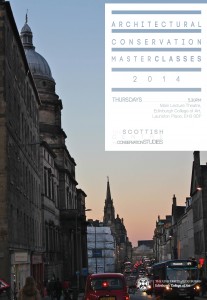Yasmin Ali
Urbanism // Design
ECA Masterclass 1: Conservation, Tourism and the Invention of Heritage 16/01/2014
January 20th, 2014
Session 1: ‘Conservation, Tourism and the Invention of Heritage’
Warwick Ball (Director, Eastern Approaches)
ECA’s annual Architectural Masterclass Series began with archaeologist Warwick Ball speaking on the topic of the invention of heritage as a draw for tourism. Taking cues from Calton Hill as a local point of departure, Ball cites Calton monument as an example of how pieces of heritage are used in an almost propagandist way to convey a sense of attachment to a legacy, in this case neoclassicism. Built at the height of the Scottish Enlightenment, Edinburgh branded itself as the ‘Athens of the North’, and saw itself as an heir to classicism.
Ball continued with several further examples of reconstructions of Greek Temples, focusing on the former USSR, who sought links to roots in its ancient Greek colonies around the Black sea. Other examples of Hellenic monuments and motifs that have been repeated throughout neoclassical and Greek revivalist architecture around Europe and Russia include triumphal arches, Roman quadriga and collonades, sometimes used for Western Imperial powers to identify with a Roman history and the glory of past empires. The Russian claim to a classical legacy was strong, especially around the Black Sea, as they sought self-identity. This imperialist classical connection continued unabated throughout the Communist period, and even following the destruction of neoclassical cities during the Crimean War and World War II.
Post-communist China has also seen a revival in neoclassical buildings, which Ball attributes to an expression of Western ideals as China looks to the Occident in the Post-Mao era. Many of the more recent of these are pastiche, but more genuine, historic examples can be found in Shanghai’s French quarter. Ball also presents and interesting discourse on the reassertion of the Silk Road, and its liminality and existence as an imagined cultural landscape, rather than a physical form in the present or the past.
The talk continues with some examples of questionable reconstructed heritage sites from Turkey, Uzbekistan and Jordan. Ball empathises with the need for South Asian and Russian states in particular to assert a sense of identity, given that their lack of continuous history, a struggle for power or independence, and a sense of arbitrary border designation. Ball ends the talk with another local example: the statue at the foot of Stirling’s Wallace monument is in fact the face of Mel Gibson, driving home the point that history can be rewritten anywhere.
---
Warwick Ball is a Near Eastern archaeologist and author who spent over twenty-five years carrying out excavations, architectural studies and monumental restoration throughout the Middle East and adjacent regions, having lived, worked and traveled in most countries between the Mediterranean and China. He excavated in Iran, Libya, Ethiopia, Afghanistan (where he was Acting Director of the British Institute of Afghan Studies), Jordan, and Iraq (where he was Director of Excavations with the British School of Archaeology in Iraq). Warwick is currently director of Eastern Approaches, a special-interest travel company that offers small group tours of cultural and historical interest.
--
Further selected masterclass reviews to follow throughout February and March
Organised jointly by The Scottish Centre for Conservation Studies and the Alwaleed Centre
With Thanks to ECA
// Session 2: 23/01/2014 Chris McGregor, Historic Scotland ‘Stanley Mill – Past to the Future’
// Masterclasses run weekly until and including 20th March 2014, from 530-730pm at Edinburgh College of Art
// Free for ECA Staff & Students / £180 for all 10 / £45 non-ECA students or £20 (£5conc.) per session, including wine
Weblinks
ECA Masterclasses here
Eastern Approaches - here
Alwaleed Centre - here
Scottish Centre for Conservation Studies - here



